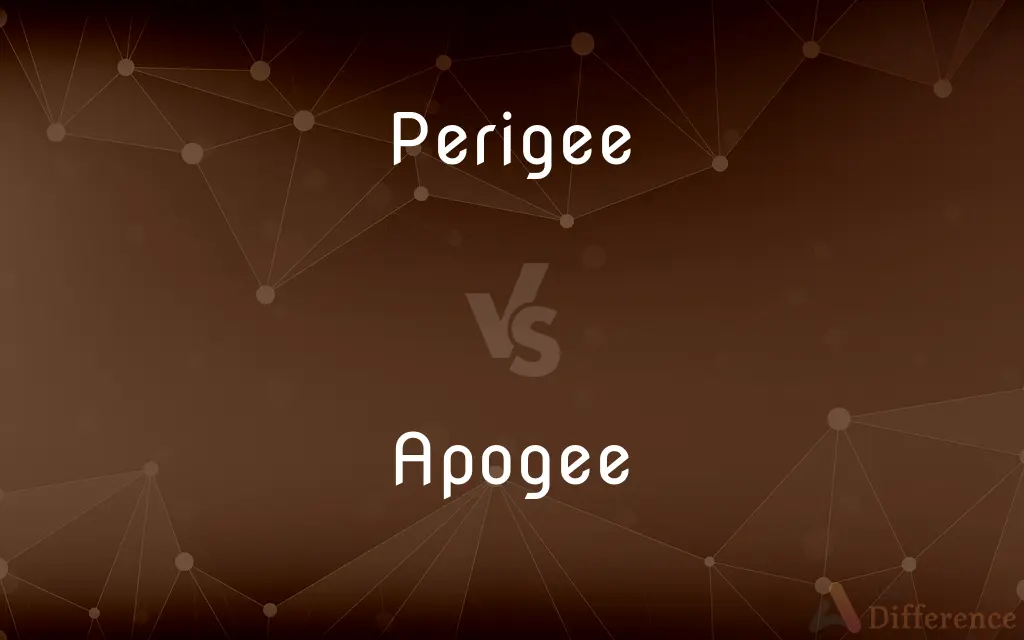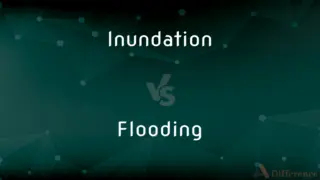Perigee vs. Apogee — What's the Difference?
Edited by Tayyaba Rehman — By Fiza Rafique — Updated on February 24, 2024
Perigee refers to the point in the orbit of the Moon or a satellite closest to Earth, emphasizing proximity, while apogee denotes the farthest point, highlighting distance.

Difference Between Perigee and Apogee
Table of Contents
ADVERTISEMENT
Key Differences
Perigee and apogee represent two extremes in the elliptical orbit of an object around Earth. When the Moon or a satellite is at its perigee, it is closest to Earth, which can affect its apparent size in the sky and gravitational influences.
At apogee, the object is at its furthest point from Earth, which can lead to it appearing smaller and having less gravitational impact. These points are crucial for understanding the dynamics of orbits, especially in planning satellite missions and observing lunar phenomena.
The distance at perigee can significantly differ from the distance at apogee due to the elliptical nature of orbits, leading to noticeable variations in observations from Earth.
Timing and location of perigee and apogee can influence tidal forces, with perigee tides being stronger, known as "perigean tides," compared to weaker tides at apogee.
Comparison Chart
Definition
Closest point to Earth in an orbit
Farthest point from Earth in an orbit
ADVERTISEMENT
Distance
Shortest distance to Earth
Longest distance from Earth
Observational Impact
Larger apparent size, stronger gravitational effects
Smaller apparent size, weaker gravitational effects
Tidal Influence
Higher, leading to perigean tides
Lower, leading to weaker tides
Relevance
Key for satellite deployment near Earth
Important for missions requiring greater Earth clearance
Compare with Definitions
Perigee
The point in the orbit closest to Earth.
The satellite's perigee is when it's most visible from Earth.
Apogee
The point in an orbit farthest from Earth.
The satellite reaches its apogee late in the orbit.
Perigee
The minimum orbital distance from Earth.
At perigee, the Moon appears larger in the night sky.
Apogee
The maximum orbital distance from Earth.
At apogee, the Moon appears smaller to observers on Earth.
Perigee
Related to gravitational pull.
The satellite experiences the strongest gravitational pull at perigee.
Apogee
Crucial for high-altitude orbits.
The communication satellite's apogee determines its coverage area.
Perigee
Used in satellite mission planning.
The spacecraft will deploy its payload at perigee.
Apogee
Pertains to gravitational effects.
The gravitational pull at apogee is the weakest.
Perigee
Affects tidal forces.
Tides are higher when the Moon is at perigee.
Apogee
Influences tidal forces minimally.
Tides are lower when the Moon is at apogee.
Perigee
(astronomy) The point, in an orbit about the Earth, that is closest to the Earth: the periapsis of an Earth orbiter.
Apogee
The analogous point in an orbit around a celestial body other than Earth. Not in technical use.
Perigee
(Astronomy)The point in an orbit around the planet Earth where the orbiting body is closest to the planet.
Apogee
(astronomy) The point, in an orbit about the Earth, that is farthest from the Earth: the apoapsis of an Earth orbiter.
Perigee
The analogous point in an orbit around a celestial body other than Earth. Not in technical use.
Apogee
Apoapsis in Earth orbit; the point in its orbit where a satellite is at the greatest distance from the Earth
Perigee
The point, in an orbit about any planet, that is closest to the planet: the periapsis of any satellite.
Apogee
(Astronomy)The point in an orbit around the planet Earth where the orbiting body is farthest from the planet.
Perigee
The point, in any trajectory of an object in space, where it is closest to the Earth.
Apogee
The farthest or highest point; the apex:"The golden age of American sail, which began with the fast clipper ships in 1848, reached its apogee in the Gold Rush years"(Los Angeles Times).
Perigee
That point, in the orbit of the moon or other body orbiting the earth, which is nearest to the earth; - opposed to apogee. It is sometimes, but rarely, used of the nearest points of bodies not orbiting the earth, such as of a comet, a planet, etc. Called also epigee, epigeum.
Apogee
The point, in an orbit about any planet, that is farthest from the planet: the apoapsis of any satellite.
Perigee
Periapsis in Earth orbit; the point in its orbit where a satellite is nearest to the Earth
Apogee
The point, in any trajectory of an object in space, where it is farthest from the Earth.
Apogee
That point in the orbit of the moon which is at the greatest distance from the earth.
Common Curiosities
How do perigee and apogee affect the Moon's appearance?
The Moon appears larger at perigee and smaller at apogee due to the difference in distance.
Is the distance at perigee always the same?
No, the distance at perigee can vary slightly due to orbital eccentricity.
Can perigee and apogee affect satellite imaging?
Yes, imaging resolution can be higher at perigee due to closer proximity to Earth.
What is a supermoon?
A supermoon occurs when a full Moon coincides with its perigee, appearing larger and brighter.
What is perigee?
Perigee is the point in the orbit of a celestial body where it is closest to Earth.
What is apogee?
Apogee is the point in an orbit where the celestial body is farthest from Earth.
Do perigee and apogee influence tides?
Yes, tides are stronger at perigee and weaker at apogee due to gravitational forces.
Are perigee and apogee only related to the Moon?
No, they apply to any object orbiting Earth, including satellites.
What is the significance of apogee in satellite communication?
The apogee of a satellite determines its coverage area and signal strength.
Is there a difference in speed between perigee and apogee?
Yes, an object moves faster at perigee due to stronger gravitational pull and slower at apogee.
What is perigean spring tide?
A perigean spring tide is an especially high tide that occurs when the Moon is at or near its closest point to Earth.
How often does the Moon reach perigee?
The Moon reaches perigee approximately once a month.
Can perigee and apogee be calculated precisely?
Yes, using orbital mechanics and observational data, their timing and distance can be precisely calculated.
How do perigee and apogee impact space missions?
They are crucial for mission planning, particularly for launch windows and satellite deployment.
How do astronomers use perigee and apogee?
Astronomers use them to predict celestial events and understand orbital dynamics.
Share Your Discovery

Previous Comparison
Notch vs. Nock
Next Comparison
Inundation vs. FloodingAuthor Spotlight
Written by
Fiza RafiqueFiza Rafique is a skilled content writer at AskDifference.com, where she meticulously refines and enhances written pieces. Drawing from her vast editorial expertise, Fiza ensures clarity, accuracy, and precision in every article. Passionate about language, she continually seeks to elevate the quality of content for readers worldwide.
Edited by
Tayyaba RehmanTayyaba Rehman is a distinguished writer, currently serving as a primary contributor to askdifference.com. As a researcher in semantics and etymology, Tayyaba's passion for the complexity of languages and their distinctions has found a perfect home on the platform. Tayyaba delves into the intricacies of language, distinguishing between commonly confused words and phrases, thereby providing clarity for readers worldwide.















































